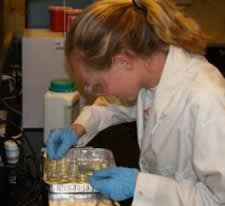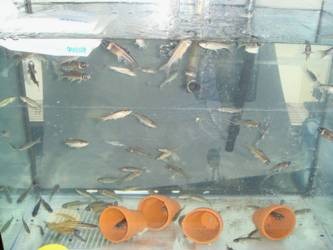Kendra Kesty
Ecotoxicology of photolyzed agrochemicals
Biology/Chemistry, Drs. Carlin, Nienow, Elias

About My Research:
The pesticides and herbicides that farmers apply to their fields increase their crop yield by decreasing the amount destroyed by pests or weeds. However when wind or water brings these compounds into the surrounding streams, they may have adverse affects to the surrounding ecosystems. The ecosystem can be exposed to the original pesticide but can also be exposed to the breakdown products caused by the pesticide's exposure to water or sunlight. This summer I have been studying the UV light breakdown products of a commercially successful pesticide and have learned how I can best determine what their effect will be or has been on fish in exposed ecosystems.
The active ingredient of the commercial pesticide Frontier has been especially interesting and reactive in different wavelengths of light. Also we chose to expose to these chemicals to two small aquatic vertebrates, zebra fish and fat-head minnows. Zebra fish are a model organism with well-known genetics and development, and fat-head minnows are at the bottom of the food chain in Minnesota, so these animals would be one of the first vertebrates to show effects, if any, from exposure to a toxic compound.
This research was supported by the 2008 Merck-AAAS Summer Research Fund.
In the student's own words :
"What is the best part of doing research at Gustavus?
The faculty. I'm doing a research project in the area of ecotoxicology requiring one chemistry and two biology advisors. All three have been enthusiastic about the project and very patient with me when I'm learning. I enjoy coming to work because they have provided an environment that encourages curiosity, a sense of humor, and hard work. Also, this summer I have been overwhelmed with the interest in my project from other faculty in relevant specialties such as neurology, biochemistry, and organic chemistry. Many have supported my project and contributed great ideas."
Professional Abstract:
The objective of this research is to develop protocols to systematically observe and
document effects of an agrochemical and its breakdown products on aquatic organisms. We
studied the compound dimethenamid, found in the herbicide Frontier®, because it has a
relatively high toxicity and concentration in Midwest streams. We exposed dimethenamid to
two small vertebrates, fathead minnows (Pimephales promelas) and zebra fish (Danio rerio),
using different methods and analyzed the tissue to look for gross anatomical changes after
each exposure.
Links:
- Learn more about the Department of Biology
- Learn more about the Department of Chemistry
- Go to the student's Faculty Research Advisors' Homepage:
Update:
Kendra presented her data at the 2008 Fall Chemistry-Biology Research Symposium.
